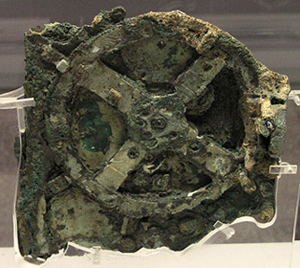|
The Antikythera Mechanism is the earliest known analog computer. It was discovered in 1900 by sponge divers exploring a Roman shipwreck off the coast of the Island of Antikythera near Greece. It is believed to have been created before 100 B.C., perhaps even before 200 B.C.
John Walrod of Antique Maison in Bay St. Louis, Miss., Scott and Carolyn Brown of Memories Flea An’Tique Mall in Montgomery, Ala., Ted Carlton of Utah, and Keith Nansteel correctly identified the Mechanism.
Bronze statues on the sea floor first attracted the attention of the divers. The shipwreck is now thought to have been a treasure ship because it also contained pottery, glass, coins, jewelry, marble statues of horses and the Antikythera Mechanism.
|

Antikythera Mechanism
|
More than 30 bronze gears and 80 fragments of the Mechanism were found. According to Michael Wright, the curator of a museum in London who created a working model of the Mechanism, It may have originally been constructed with 50 or 60 gears.1 Incredibly, the Mechanism is only 3.5 inches thick, a miracle of miniaturization in the ancient world. In all, it measures 13 inches high and 6.75 inches wide. The largest gear is about 5.5 inches in diameter and has 223 teeth.
The diminutive size of the Mechanism is impressive, but the functions of the Mechanism are incredible. It had working dials on both the front and on the back. When a knob on the side was turned, a dial showed the cycles of the moon and sun and the movements of Mercury, Venus, Mars, Jupiter and Saturn. On the back were two dials with a zodiac in the inner ring and a calendar of 365 days on the outer ring. The circular calendar also showed 235 months, or 19 years. This is called a Metonic Cycle, so named for Meton of Athens (5th century B.C.) who discovered that 235 lunar months are almost exactly equal to 19 solar years. The Greeks used this cycle as the basis for their calendar since 12 lunar months do not equal 365 days.
The dial also shows a 76-year cycle (four Metonic Cyles of 19 years each) for showing when eclipses will occur. New research is pointing to the Antikythera Mechanism being created before 200 B.C. because this dials shows an eclipse in 205 B.C.
A small dial on the same side was a four-year calendar showing when Olympic and Panhellenic games would occur. The Greek schedule of games was arranged so they happened every year. They were: the Olympic Games (every four years); Pythian Games (every four years): Nemean Games (every two years); and Isthmian Games (every two years). After the Olympic Games, the Nemean and Isthmian Games were held the following year. Then the Pythian Games were held the next year and were followed by the Nemean and Ishmian games before starting the cycle over with the Olympic Games.
It is easy to see why the Antikythera Mechanism would be very handy for keeping the schedule of games straight—and for tracking the orbits of planets, the phases of the moon, predicting eclipses and so on.
Impressed?
When the mechanism was found, it was so encrusted it looked like a ball of rock. A gear was noticed after the rock naturally cracked open, but it wasn’t until the 1950s that it was realized that the Mechanism marked the cycle of the planets and moon. In 1971, the Mechanism was x-rayed which showed inscriptions, including the names of the months of the year on the calendar. The inscriptions were later determined to be Corinthian, and since Archimedes resided in a Corinthian colony, some have speculated that he was the creator of the Antikythera Mechanism. It was not until after the turn of this century that the functions of the other dials and gears were determined.
The Antikythera Mechanism is a wonder of the ancient world, and if it had not been lost in a shipwreck, we would have never known about it.
-------------------------
1 www.age-of-the-sage.org/archaeology/antikythera_mechanism.html
|